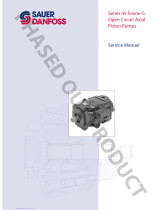
Port locations and gauge installation.....................................................................................................................................24
Troubleshooting
Overview........................................................................................................................................................................................... 27
Neutral difficult or impossible to find.....................................................................................................................................27
System operating hot...................................................................................................................................................................27
Transmission operates normally in one direction only....................................................................................................27
System will not operate in either direction.......................................................................................................................... 28
Low motor output torque...........................................................................................................................................................28
Improper motor output speed..................................................................................................................................................28
System noise or vibration........................................................................................................................................................... 29
System response is sluggish...................................................................................................................................................... 29
Adjustments
Standard procedures, inspections, and adjustments....................................................................................................... 30
Adjustments.....................................................................................................................................................................................30
Charge pressure relief valve adjustment...............................................................................................................................30
Multi-function valve pressure adjustment............................................................................................................................32
Engaging the bypass function.................................................................................................................................................. 33
Pressure override (POR) valve pressure adjustment (option for 180 frame size)....................................................34
Displacement limiter adjustment............................................................................................................................................ 35
Control Neutral Adjustment.......................................................................................................................................................36
Verify neutral setting...............................................................................................................................................................37
Servo Adjustment Side M4....................................................................................................................................................37
Standard manual displacement control (MDC) adjustment..........................................................................................38
Non-linear manual displacement control (MDC)............................................................................................................... 38
MDC Neutral start switch (NSS) adjustments.......................................................................................................................39
Checking switch continuity........................................................................................................................................................42
Hydraulic displacement control (HDC) and electric displacement control (EDC) adjustment..........................43
Speed sensor adjustment........................................................................................................................................................... 44
Minor repair
Standard procedures....................................................................................................................................................................46
Shaft seal and shaft replacement.............................................................................................................................................46
Multi-function valve cartridges.................................................................................................................................................49
Multi-function valve cartridges - pre 1988............................................................................................................................51
Pressure override valve (option for 180 frame size)..........................................................................................................53
Charge pressure relief valve.......................................................................................................................................................53
Adding an Auxiliary pad to a pump previously without one.........................................................................................55
Auxiliary pad....................................................................................................................................................................................56
Charge pump...................................................................................................................................................................................57
Integral charge pressure filter replacement.........................................................................................................................61
Pump control cover plate........................................................................................................................................................... 63
Displacement control orifices....................................................................................................................................................63
Displacement control orifice check valve............................................................................................................................. 64
Displacement control adapter plate (early production 130 pumps only).................................................................64
Manual displacement control (MDC)......................................................................................................................................65
Solenoid override valve for MDC..............................................................................................................................................66
Solenoid override valve for MDC with pressure released brake...................................................................................67
Hydraulic and electric displacement controls.....................................................................................................................68
Pressure control pilot (PCP) for electric displacement control (EDC)..........................................................................70
3-Position (FNR) electric control...............................................................................................................................................70
Displacement control filter screens.........................................................................................................................................72
Speed sensor................................................................................................................................................................................... 72
Control Module Repair.................................................................................................................................................................73
Replace control solenoids/actuator housing.......................................................................................................................75
Torque chart
Fastener size and torque chart..................................................................................................................................................76
Plug size and torque chart..........................................................................................................................................................77
Fasteners and plugs......................................................................................................................................................................78
Service Manual
Series 90 Pumps
Contents
4 |
©
Danfoss | February 2020 AX152886483063en-000203






















